#perennial flax
Text
Seeds to Plant In Fall
Some plants need to go through winter in order to germinate! You can trick them into thinking this has happened by freezing/refrigerating them in early spring, or you can save yourself the trouble, plant them in fall, and let nature do the work. (As with all things gardening, this will vary depending on your climate! This list is from Fedco Seeds (my beloved) and is suitable for Northern zones with long, cold winters)
Herbs:
Bergamot
Borage
Catnip
Hyssop
Lavender
Lovage
Marshmallow
Motherwort
Parsley (give them a nice long time for their 7 trips to Hell and back)
St John’s Wort
Creeping Thyme
Yarrow
Flowers:
Butterfly Weed
Calendula
Chinese Lantern
Dyer’s Coreopsis
Blue Flax
Hollyhock
Honesty
Joe Pye Weed
Johnny Jump-Up
Kiss-Me-Over-The-Garden-Gate
Larkspur
Lupine
Perennial Phlox
Sweet Annie
And, not a seed but one of the most important fall plantings:
Garlic!
223 notes
·
View notes
Text
my beloveds as flowers 🌻
@teamlighthouse - perennial flax
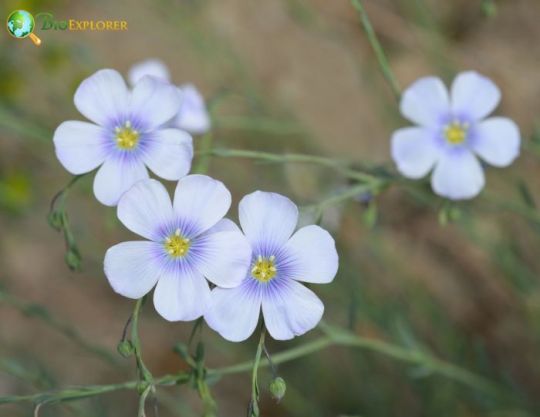
@ginkgo-shaw - cyclamen
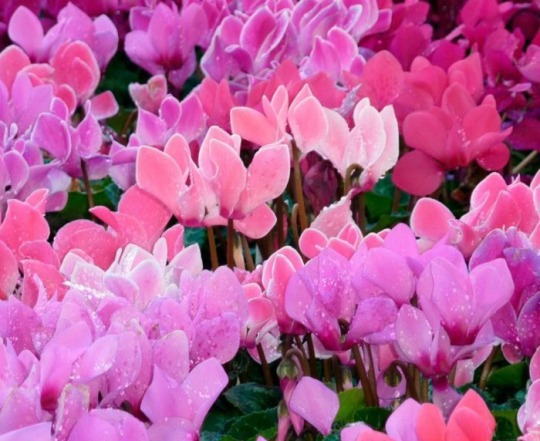
@mostlybbucky - ipomoea

@ambersock - delphinium
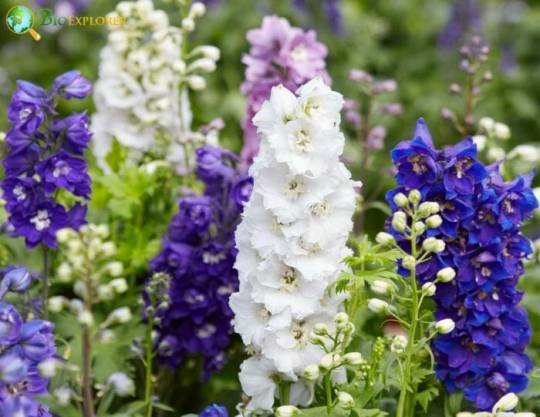
@arcanespillo - japanese snake gourd
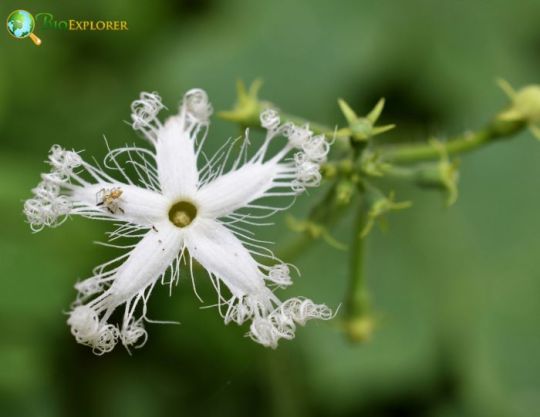
@asphaltaxismundi - thornapple
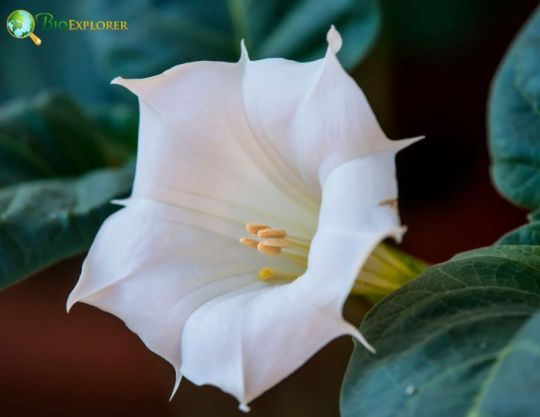
@natequarter - mandrake

@jackiefour - ranunculus

@the-tenth-arcanum - gardenia

@cassiusthecorrupterofsouls - black rose

and i'm a gayfeather 💖
there are some people that i was too shy to tag, but know that you, too, are beloved. if anyone needs an image description, just hit me up!
20 notes
·
View notes
Text
Fun notes from Hellstrip Gardening by Evelyn J. Hadden
I’d mentioned in my liveblogging notes that I’d share the cool stuff I learned/found interesting but my notes quickly got Very Long so they’re now their own post. Seeing as this is what I personally found noteworthy, I definitely encourage people read the book for themselves—you might find value in a place I looked over!
Working with Poor Soil
- Use plants that thrive in less than ideal soil
- Grow herbs 👀 many common perennial herbs like thyme, sage, and oregano prefer nutrient-poor soil and dry conditions make them more flavorful. BUT get your soil tested first. Nitrogen fixers will improve poor soils and manage fine on their own, like false indigo. Flax, penstemons, and salvias are plants that are well adapted to lean growing conditions. I found this interesting because whenever I plant salvias in my garden I give them Scoops of Compost but I guess its not needed lol.
- Deep rooted prairie grasses and flowers can withstand the extremes of clay soil flipping between too wet and too dry. Some sturdy taprooted plants can break through compacted soil.
- If your soil is BAD bad then grow in containers and/or raised beds! It’ll be less costly than trying to improve a huge swath of shitty soil on your own. They’ll also provide textural interest to the landscape.
- Use a fork or pitchfork to improve compacted soil, or a broad-fork. Near tree roots, try pushing a stick/stake/rigid object into the ground and then remove it to make holes where water and organic matter can enter.
- To boost fertility quickly, add dehydrated manure, leaf mold, mushroom compost, alfalfa pellets, or garden compost. I had no idea what an alfalfa pellet was before this.
- Grow annuals for a year, cut them off at the ground level in fall, and leave the roots to decay in place. Plants with big taproots will also help break up soil. Letting roots rot in place create channels of organic matter to aerate soil, hold water, and hold nutrients.
- Sheet mulch
- When it comes to contaminated soils, you can remove the top layer of soil and replace it with good soil, or add the fresh soil on top in raised beds or mounded into berms. If you aren’t in a hurry, certain plants and fungi can be used to phytoremediate or mycoremediate the soil. They remove contaminants and store them in their tissues—you have to remove and dispose of them after though.
- Sunflowers remove lead from soil and store it in their tissues. Increasing their potassium levels increases their effectiveness for this. Cut plants after the growing season and dispose as hazardous waste. Good news! According to this book, the lead and other toxins don’t really accumulate in the seeds, so its safe for seed-eating birds. And since its stored in tissues idk if it’d affect pollinators either?
- Cover bare soil under the phytoremediating plants with a thick mulch or dense ground-covers. For easy living mulch, the book suggests Dutch white clover, annual sweet alyssum, or johnny jump-ups.
- Phytoremediation and mycoremediation require a lot more patience than just removing and replacing soil. It can take a decade or longer, depending on the situation. Definitely test the soil before you use it for other purposes, even if you’ve been phytoremediating.
Working with Laws and Covenants
- Know what the regulations are. This can include what trees are and aren’t allowed to be planted on roadsides, if trees are allowed in strips of certain widths, plant height at intersections, etc. However its also possible that the city will plant a tree for you if its on their list and you qualify, saving you money.
- When confronting a restrictive regulation (esp if written decades ago) whether its from an HOA or a city ordinance, don’t assume it can’t be revised, varied, or taken out entirely after some prompting. Have a civil conversation about it, draw up a plan or describe your garden plan, maybe be ready to make a formal presentation.
- You’ll have more luck if you come to the bargaining table prepared to and willing to compromise, take feedback, address concerns with facts and examples. Offer to meet again after the landscape is in place. Honestly I find this point interesting because the mindset of a lot of people frequently is ‘ask forgiveness not permission don’t ask and fight them if they get pissed’ but also in some situations asking cordially can get the results you want more painlessly. (That being said if lawn lovers dig in their heels maybe then its time to rally the forces and protest it but yknow cross that bridge when you get there I guess)
- Know the applicable laws. Some states (the book lists Colorado, Texas, California, Nevada, and Florida) hqve laws preventing HOAs from prohibiting xeriscaping.
- When proposing/fighting for your garden, focus on practical benefits that are easier to quantify and communicate than emotions and personal values. An HOA might not necessarily care about pollinator habitat, but they might be more understanding of ‘reducing water runoff, erosion control, lower energy use, less water needs, and no noisy mowers and blowers to bother neighbors with and spend money maintaining.’ Assigning dollar values to the garden will help communicate other positives—even if its not your main focus. Speak to them in their language, not necessarily your own.
- Show pictures of examples! If there’s a similar garden elsewhere in town, tell them where they can find it to see for themselves that it Works and Looks Great. Show them that others are doing this kind of stuff and it’ll adjust their view on ‘normal’ and ‘acceptable’ landscaping choices.
- Consider adding barriers to your beds and paths to help neighbors see that it’s ‘managed’ and actively cared for/enjoyed. Including a path and maybe a bench or some chairs will help it read as more Orderly. Wider paths will also alleviate fears about ticks, snakes, etc.
- If your neighbors aren’t crazy about a meadow garden, a no-mow lawn or groundcovers can give the look and feel of a lawn without being lawn if compromising is needed.
- Get a garden club or other local group to back you up. If there isn’t one already 👀 make one.
Living with Vehicles
- Sometimes if you garden close to the road cars might accidentally drive over parts of it, especially if parking. Put plants that are more easily replaceable on the forefront, and don’t forget to aerate the compacted soil afterwards.
- You could also put in a low fence/wall, a row of rocks, prickly plants or shrubs, or brightly colored taller plants to make the garden More Obvious and Less Drive-On-Able. If it keeps happening maybe request a cautionary sign or speed bump be added, or that a visibility barrier be removed.
- If there’s part of the garden you wanna save for occasional driving/parking, use plants that can be mowed when needed, or install permeable pavement/gravel/driving strips through a low ground cover planting. You can add a barrier that can either be mowed down or moved when that area’s not being used.
- If you have a Hellstrip hellstrip (which this book ends up talking a lot about Total Lawn Transformations but there’s still a lot of hellstrip advice too) then the combo of asphalt on one side and sidewalk on the other is gonna make a heat island. Find plants that like the heat! Use that strip to extend your growing season for warmth loving annuals or even for edible plants like tomatoes, peppers, squash, and melons! BUT get your soil tested before you do that.
- Alternatively you could plant trees to help shade the area and cool it down
- MULCH
- You can plant things to help muffle the sounds smells and other effects of traffic, winds, and passerby. You’ll want a four season barrier for this—plant a variety of things that’ll either stay green and leafed up in Winter or at least add visual interest.
Living with Wildlife
- So apparently geese like to eat the blades of grass lawns??? I thought they were eating bugs IN the grass, not the grass itself. Anyways they especially love eating fresh grass in view of a shoreline so you could add a 20 foot wide buffer of tall plants between the lawn and the shore if you don’t wanna deal with Goose Poop
- Mosquitoes lay eggs in standing water but apparently can also lay eggs in really wet dirt which I DID NOT know so even a leaky faucet onto some dirt can cause issues with mosquitoes.
- According to the book, humans don’t tend to notice damage to leaves until it surpasses ~10%, and don’t notice a particular kind of insect until its population surpasses a certain number of individuals. So instead of trying to eliminate all leaf-eating bugs, aim to control their populations so the damage isn’t noticeable to you and the insect predators will remain in the landscape and continue controlling said population. However, I took note because hey if you plant host plants and either have so many of them or manage to sneak them into so many different places that the leaf damage becomes Barely Noticeable…. Idk that just feels like a good thing to take note of for Sneaky Pollinator Gardening purposes.
- In areas prone to ticks, make your paths wide enough to pass through without touching foliage. Also having other animals around can minimize exposure—pheasants, chickens, and guinea fowl actively seek and eat ticks while possums and raccoons attract them and kill them while grooming. HOWEVER. Mice and deer can be sources of tick reproduction.
- Diverse plantings can limit damage from both insect herbivores as well as larger herbivores like rabbits, deer, and birds. These animals are generalists but may focus on specific favorites, so a mixed variety might get nibbled a little but mostly left alone.
- As a general rule, herbivores are attracted to nitrogen content in foliage, plants kept well watered, and new growth. Pampered plants are more appealing.
- Planting favorites like clover or alfalfa in specific areas may keep herbivores from finding (or at least encourage them to ignore) other areas like a veggie garden. A mulberry tree may make birds ignore your other fruits. A well placed shrub can host a rabbit nest instead of the underside of a deck. Piling ripe seed heads of grasses and flowers alongside an alley or generally away from your house can lure mice away from said house (and possibly expose them to more predators along the way)
- Vertical gardens, cold frames, hoop houses, and green houses can protect edible plants from herbivores
- Maintaining an excessively tidy lawn is a high effort way to avoid contact with particular local species (ticks, snakes, black widows, scorpions, etc.) Gaining more knowledge might help find easier ways to avoid the animal and give more peace of mind. Slight modifications could keep the animal out of your immediate environment. Its possible they aren’t even interested. (This feels fantastic but I feel like the last time I tried to read up on ‘how to keep snakes away from house/out of garden’ the results were basically Dont Have A Garden And Dont Go Outside so)
- I now want a garden toad friend time to find a broken pot to put upside down in the garden
- Early spring bulbs like low iris, species tulips, hyacinths, and crocus will supply nectar at a highly valuable time of year, attracting pollinators to the garden.
- Cleaning up fallen leaves destroys butterflies overwintering under plants.
- Birds will be lured in by the sound of moving water.
- Include prickly shrubs and thorned trees to help give birds a hiding space from predators like hawks or urban cats. Just keep thorny branches out of pathways.
Living with Road Maintenance and Utilities
- If you live in a place where roads are sanded or salted in winter, try to find salt-tolerant plants for your area. To protect curbsides from water logging and salt buildup, slope the ground towards the road/path. Direct salt-laden runoff into a seasonal stream or rain garden planted with salt-resistant species. A berm and/or row of salt-tolerant plants can protect sensitive plants from said salts. Frequent shallow waterings create a buildup of salts in the top layer of soil—deep watering helps flush salts out of the soil.
- Plants can be damaged by piling snow, and soil can be compacted underneath. Make sure the garden includes an area for piling snow, possibly a rain garde or bioswale to shovel into/let meltwater flow to.
- call the local utility company before you make bigass changes to your lawn PLEASE don’t hit a utility line. Also don’t plant tough, deep-rooted masses of roots over shallowly buried utility lines. Consider paths of loose gravel/mulch/stepping stones, shallow-rooted ground covers, and/or annuals and other easily replaced plants.
- Vines can be grown on individual wires, metal fencing, latticework, or wooden poles. Match the vine’s growth habit to the structure you want it to climb. HOWEVER regulations may prohibit stuff like this, and you’ll have to be ready to move/remove any added trellising and plants when maintenance time comes around.
- Shrubs can conceal metal boxes and other equipment, or you can use perennials. When using foliage to hide electrical boxes and other utility containers, keep clear access to any doors and allow their complete range of motion.
- If you can’t/don’t want to mask an object, try shielding it from view in certain vantage points. Or incorporate the colors of the equipment into the garden by mimicking the color scheme.
Living with the Public
- Especially if you’ve got a sidewalk running through the front yard, you have to consider EVERYBODY who’s going through there. Strangers, neighbors, vehicles, animals. Pedestrian traffic is an important consideration—wheelchair users, strollers, children, dogs, and depending on where you are even horses are something to keep in mind.
- Elements that can encourage traffic include mat forming ground covers, level places, and paved/graveled/mulched open areas. Elements that discourage traffic include protective fencing, uneven or sloping surfaces, and plants that are tall or look uncomfortable to touch.
- To minimize damage from foot traffic, enlist self-repairing plants whose stems are capable of rerooting when they’re broken and come into contact with soil. Self sowing plants can seed to fill in bare spots, and running plants can spread to fill gaps.
- Protect your nonwalkable plants with edges, hedges, and other hardscape choices. Berming or hollowing planting areas while keeping paths level can be a more effective strategy. Or you can densely plant s low, prickling, spreading shrub to bar passage.
- If visitors will be parking on the street, make sure they can exit their cars safely, and provide a clear path to your door. Said path can be straight and wide, or meandering. Guests on wheels need to be considered though.
- Plants with high moisture content should be planted closer to the curb where fire is a concern. Idling cars can emit occasional sparks and you don’t want long dry grass catching a spark. Instead consider succulents or a rock/stepping stone border along the edge, and keep dry leaves/pine needles from accumulating near parking.
- Fruit or nut trees can yield a notable surplus. Check for gleaning organizations in the community that may pick your extra edibles for personal use or charitable distribution. Or leave them for neighbors to enjoy.
- When clearing paths consider people’s feet and their faces. Keep prickly branches out of the way, take note of sharp leaves or pollen-laden plants that can make a walkway into an obstacle course hazard. If your area is prone to ticks, keep vegetation far enough from the public walk that it won’t brush against people.
- Some people don’t fucking respect gardens, or don’t have manners. Don’t put super mega rarities or plants you can’t afford to lose where the public can access them easily. Or like. You can. But be warned I’ve seen at least 5 stories of people’s front gardens getting defoliated for ‘bouquets’.
- Frequent presence in a garden (or signs of it) can deter littering, vandalism, and other mischief. A garden that looks well kept can discourage negative attention.
- Consider the garden from several points of view. If you’ve got a lot of neighborhood kids and dogs running around, keep poisonous plants near the back. A mulching of large rocks can lead to trouble with rambunctious gremlins. Etc etc.
- The curbside garden can be a great way to build community. You can even encourage communal use. Include a bench for chilling near the sidewalk, fresh food free for all to pick, a sunflower house or bed of pine cones for kids to play, a bowl of water for passing dogs, etc.
- if you want more curbside gardens in your area, consider sharing extra plants, forming a neighborhood garden club, make a list of Good Neighborhood Plants, establish a local contest, give tours of your yard, persuade a local agency or organization to offer grants, and/or lobby to change restrictive regulations.
8 notes
·
View notes
Text
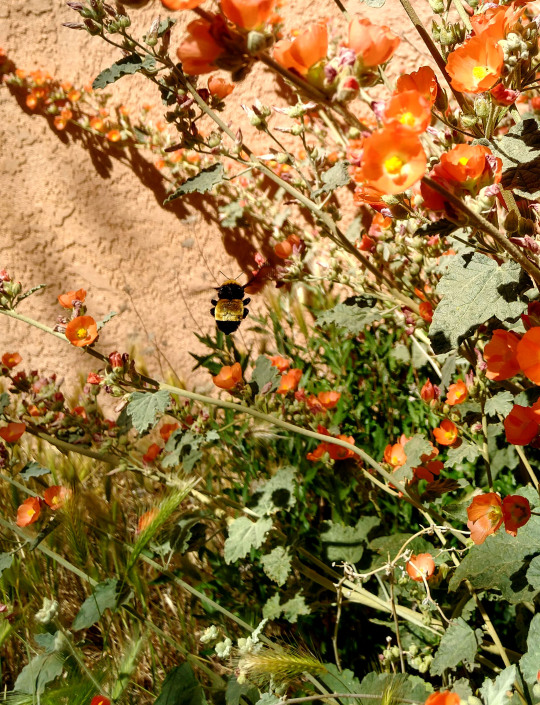


I tried doing some mild color correction on a few of those globe mallow photos, and clipped the lower left one so the bumblebee is a bit more obvious.
I am terrible about going outside, and horrible at tending my yard on my own, but I love the 'everything just go bonkers nuts wild' garden outside my bathroom window. It isn't all native, there's those red firecracker plants, some flax that seeded itself from the neighbor's yard or birdseed, some other drought resistant perennials that local nurseries just told me bees would love, and Oreo's rose tombstone is in there somewhere, and it's all just doing dandy even with me forgetting to water often enough once it gets hot.
Apparently some terrible-taste, misinformed locals feel globe mallow is a weed to be eradicated, but I went and paid for a native wildflower pack with them in it- there were also some sort of firewheel daisy like plants that did come up the first year and reseeded, but only the globe mallow is really going forward strong, it really is a tough customer, and imo very pretty.
3 notes
·
View notes
Text
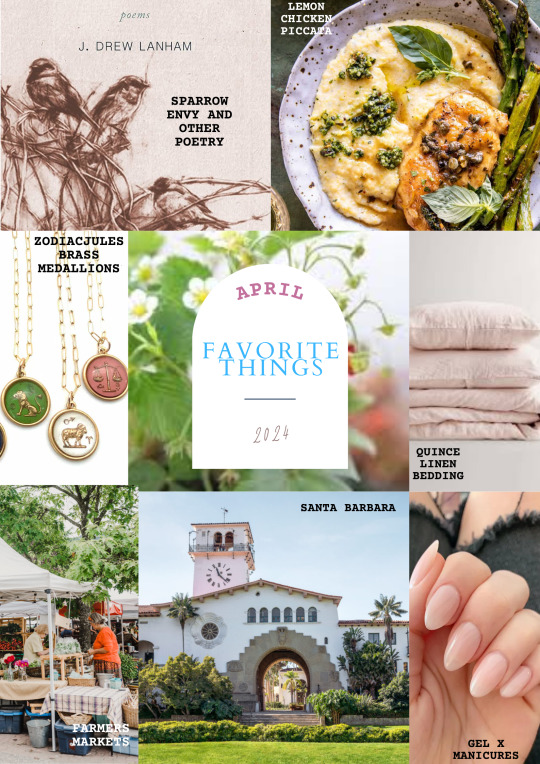
#april favorites#gpoy#april#april 2024#strawberries#gel x nails#santa barbara#farmers' market#quince linen#zodiac jules#charm necklace#lemon chicken piccata#half baked harvest#sparrow envy#poetry
0 notes
Text
Unveiling the Timeless Charm of Men's Linen Shirts: Style Tips and Trends
Introduction
Men's linen shirts have long been celebrated for their timeless charm and versatility. From casual beach outings to semi-formal events, linen shirts offer a unique combination of comfort, breathability, and effortless style. In this guide, we'll uncover the enduring appeal of men's linen shirts, exploring style tips, trends, and how to incorporate them into your wardrobe for any occasion.

The Allure of Men's Linen Shirts
Linen shirts have a rich history dating back centuries, prized for their natural elegance and comfort. Made from the fibers of the flax plant, linen is known for its breathability and moisture-wicking properties, making it ideal for warmer climates. The unique texture and drape of linen shirts lend a casual yet sophisticated vibe to any outfit, evoking images of leisurely days by the seaside or alfresco gatherings with friends. Whether you're dressing for a casual day out or a more formal event, linen shirts offer a versatile option that exudes timeless charm.
Classic Styles and Silhouettes
When it comes to men linen shirt, classic styles and silhouettes reign supreme. The button-down linen shirt is a perennial favorite, offering a polished yet relaxed look that can be dressed up or down. Opt for neutral colors like white, beige, or light blue for a timeless aesthetic that pairs well with a variety of bottoms. The popover linen shirt is another popular option, featuring a half-button placket and a more casual vibe. Experiment with different collar styles, sleeve lengths, and pocket details to find the perfect linen shirt that suits your personal style.
Styling Tips
Styling men's linen shirts is all about embracing their laid-back elegance and effortless charm. Here are some style tips to help you make the most of your linen shirts:
Casual Chic: For a casual day out, pair your linen shirt with chino shorts or lightweight trousers. Roll up the sleeves and leave the top buttons undone for a relaxed vibe. Complete the look with canvas sneakers or leather sandals for a stylish yet comfortable ensemble.
Smart Casual: Dress up your linen shirt for a smart casual occasion by pairing it with tailored trousers or chinos. Tuck in your shirt for a polished appearance and add a leather belt and loafers for a sophisticated touch. Layer with a lightweight blazer or linen jacket for added refinement.
Beach Ready: Embrace the beach vibes by pairing your linen shirt with swim shorts or linen trousers. Opt for bright colors or playful patterns for a fun and laid-back look. Finish off with flip-flops or espadrilles for ultimate comfort and style.
Layering: During cooler months, layer your linen shirt under a lightweight sweater or cardigan for added warmth and dimension. Choose complementary colors and textures to create a cohesive and stylish outfit that transitions seamlessly between seasons.
Trends in Men's Linen Shirts
While classic styles will always have a place in men's fashion, there are also some emerging trends in linen shirts to keep an eye on. Oversized and relaxed-fit linen shirts are gaining popularity, offering a modern and effortless look that's perfect for casual wear. Earthy tones like sage green, terracotta, and mustard yellow are also trending in men's linen shirts, adding a touch of warmth and versatility to your wardrobe. Additionally, eco-friendly and sustainable linen shirts are becoming increasingly sought after, as consumers prioritize ethical and environmentally conscious fashion choices.
Care and Maintenance
Proper care is essential to prolong the life of your men's linen shirts and keep them looking their best. Here are some care tips to follow:
Gentle Washing: Machine wash your linen shirts on a gentle cycle with cold water to prevent shrinkage and preserve the fabric's integrity.
Mild Detergent: Use a mild detergent formulated for delicate fabrics to avoid harsh chemicals that can damage the fibers.
Air Drying: Hang your linen shirts to air dry rather than using a dryer, as high heat can cause shrinkage and weaken the fabric.
Steam Ironing: Use a steam iron on a low to medium heat setting to remove wrinkles from your linen shirts. Alternatively, embrace the natural texture for a more relaxed look.
By following these care instructions, you can ensure that your men's linen shirts remain looking fresh and stylish for years to come.
Conclusion
In conclusion, men linen shirt epitomize timeless charm and effortless style, making them a wardrobe essential for any modern gentleman. Whether you're dressing for a casual day out or a more formal occasion, linen shirts offer a versatile option that combines comfort, breathability, and sophistication. By understanding classic styles, embracing emerging trends, and following proper care instructions, you can make the most of your men's linen shirts and elevate your style to new heights. So why wait? Add a touch of timeless charm to your wardrobe with men's linen shirts today.
0 notes
Text
Implementation Timeline
I created a timeline to demonstrate the feasibility of the concept, & how it can be delivered within the next few years :)

Sources
#blog#creative#journal#creativeconceptjournal#entrepreneur#entrepreneurship#northshore#northshorehamilton#brisbane#meanjin#qld#queensland#edq#economicdevelopmentqueensland#economicdevelopmentqld
0 notes
Text
7 au 13 novembre 2022
Another short week, I’m loving this month. I finished planting all the plants I purchased from Olivier Philippe’s nursery and most of what I grew from seed this year. I also noticed that my Cattleya are sending up flower spikes, exciting !
Monday evening I took Denis to Grasse then over to La Gaude above Cagnes-sur-Mer where I met his new British plumber, Will. Denis happened to mention to Will’s wife that there are agapanthas being given away on the domaine and she decided she wanted them. We made plans to collect some on Friday.
Tuesday afternoon Alejandro came by. We had a good look around the garden and he suggested a few things I could do, though mostly it is under control. We’ve had a few days of rain now, and the prairie is going crazy. It is really filling in and there is so much going on, including several of the Cynara that I thought had died, have reappeared. I sowed some Linaria purpurea that I collected from another garden earlier this year. By luck, Wednesday afternoon, just as I finished planting, it started to rain and it rained for several hours.
Wednesday afternoon I finally got around to buying new tyres for my car. Denis went with me and I have an appointment for next Wednesday to have them fitted.
Thursday I turned my attention to doing one more good pruning of the remaining sages.
Friday morning Will came by with his van and we filled two tonne bags with agapanthas. They decided they will send a friend with an open back for one more load. It’s nice to see them going to a new home.
My right elbow is really hurting this week, unlike it has before, a very sharp pain just in the joint.
Saturday I headed to Italy with André, Denis, Éric and Luc. We caught th 08h35 from Antibes to Vintimille. We walked to Bordighera and enjoyed a nice lunch there. On the way back, during our layover in Vintimille, I ran into town to purchase two bottles of Campari. The company has decided to make it a luxury product, so it’s been removed from the supermarket shelves. It now costs nearly 18€ for one litre. However, I love it and I love negronis.


Sunday I made pancakes again for breakfast and spent the day catching up on this blog and did chores and outstanding admin. This was the last long weekend of 2022 because Christmas is on a Sunday this year.
Plant of the week
Plantaginaceae Linaria purpurea (L.) Mill.

common name(s) - purple toadflax; français : linaire pourpre
synonym(s) - Homotypic : Antirrhinum purpureum L.; Termontis purpurea (L.) Raf.; Heterotypic : Linaria purpurascens Bernh. ex Hornem.
conservation rating - none
native to - Italy
location - Domaine de l’Orangerie
leaves - erect stems clad in narrow, grey-green leaves 20 to 50mm long
flowers - raceme occupying the top of the stem; flower is between 10 and 20mm long with five lobes arranged into two lips with a spur at the end; usually light to medium purple in colour
fruit - capsule
habit - vigorous perennial herbaceous plant growing to 700mm tall
habitat - moist, moderately nutrient-rich places
pests - aphids
disease - powdery mildews
hardiness - to -20ºC (H6)
soil - moderately fertile, light, well-drained soil; sandy soil is ideal
sun - full sun
propagation - seed in pots in a cold frame in early spring; by division or softwood cuttings in spring
pruning - after flowering to prevent self-seeding
nomenclature - Plantaginaceae - plantago - foot-sole-like, feminine termination of planta, ancient Latin for the way the leaves of some lie flat on the ground, cognate with the French derivative, plantain; Linaria - from the Latin linum which means flax, referring to the resemblance of leaves of many species to the flax plant; purpurea - purple
References :
Gledhill, David, (2008) “The Names of Plants”, fourth edition; Cambridge University Press; ISBN: 978-0-52168-553-5
IUCN [online] http://www.iucnredlist.org/search [13 Nov 22]
Missouri Botanical Garden [online] https://www.missouribotanicalgarden.org/PlantFinder/PlantFinderDetails.aspx?taxonid=287005&isprofile=0&cv=5 [13 Nov 22]
Plants of the World [online] https://powo.science.kew.org/taxon/urn:lsid:ipni.org:names:1016392-2 [13 Nov 22]
Royal Horticultural Society [online] https://www.rhs.org.uk/plants/10291/i-linaria-purpurea-i/details [13 Nov 22]
Wikipedia [online] https://en.wikipedia.org/wiki/Linaria_purpurea [13 Nov 22]
World Flora Online [online] http://www.worldfloraonline.org/taxon/wfo-0000447110 [13 Nov 22]
0 notes
Text
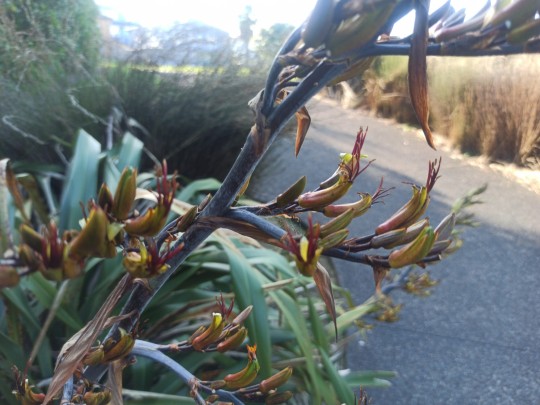
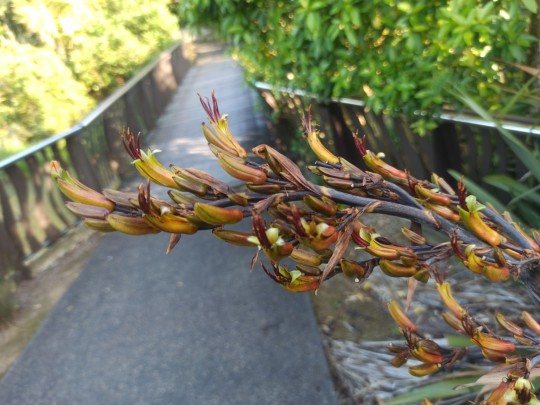
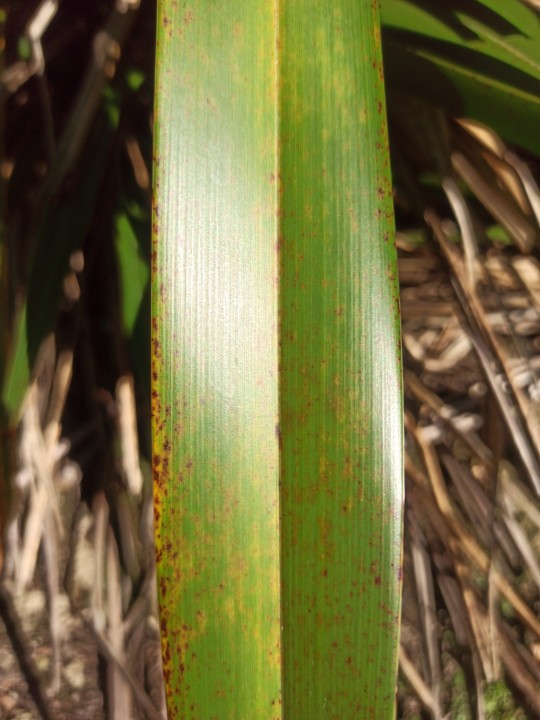
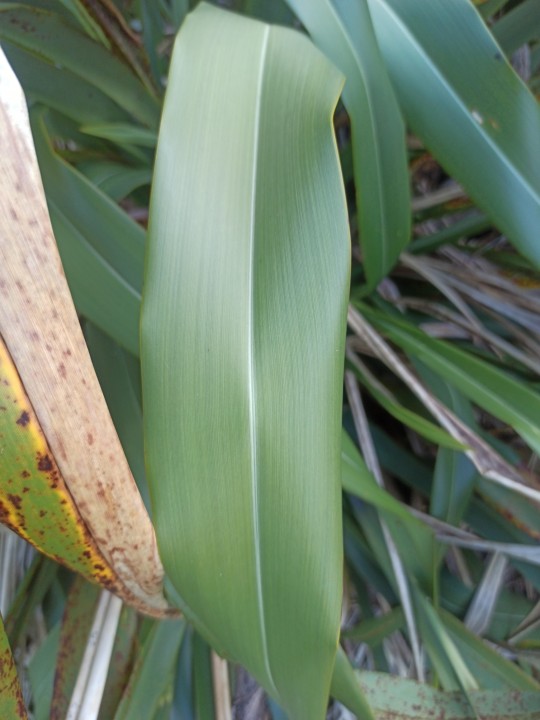
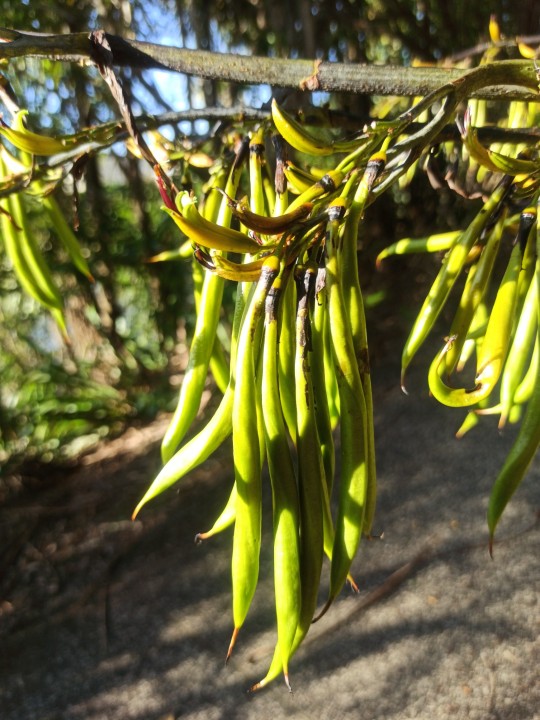
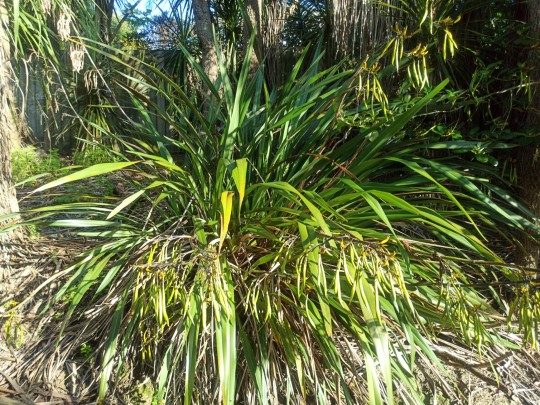
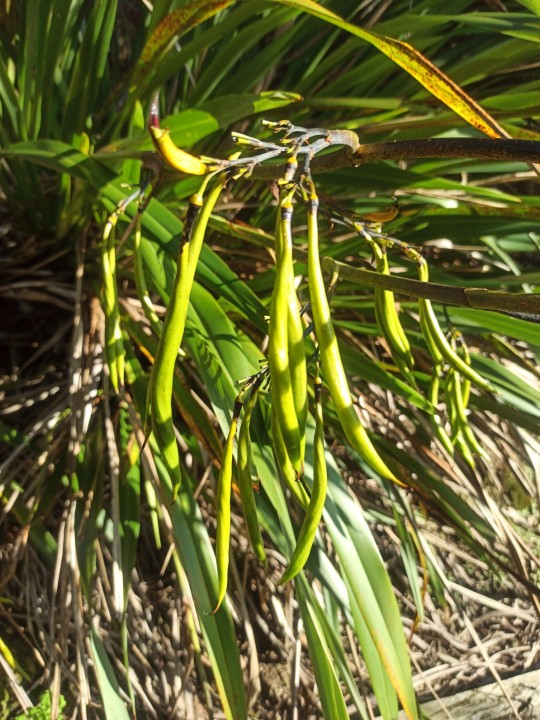


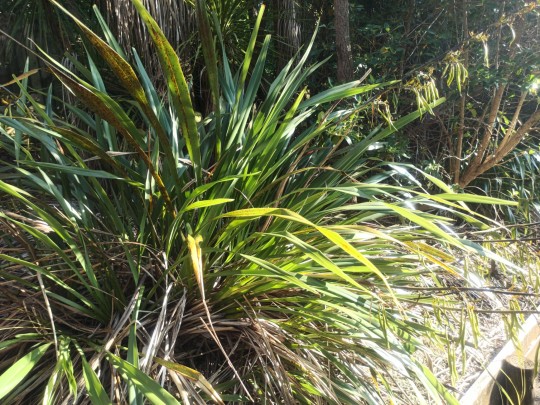
Mountain flax, a species of Phormium
Also known as:
• Lesser new zealand flax
Botanical name: Phormium colensoi
Mountain flax is a perennial considered sacred to the Māori people of New Zealand, where the plant is endemic. The Māori have historically used it to weave baskets and make waistbands. This large-leaf plant is propagated by dividing its root ball.
28 Crimson Park, Oteha, Auckland 0632
7PH9+M6X Auckland
-36.7207580, 174.7181190
0 notes
Text
Woolen Knitting Yarn supports Why Use Down Yarns?
According to Answers. com, the earliest referred to samples of yarn and textile of all kinds were determined near Robenhausen, Switzerland, wherever bundles in flax fabric and yarns and fraction of plain-weave linen textile, were estimated to be about 7, 1000 years old.
Going through the yarn section of art stores, this indicates each year numerous yarn fibres are ended and fresh fibers will be added to the combo. When I did start to crochet, I thought the only yarns that been with us were flexible plastic. But as years pass by and my love intended for crocheting grew, I began to experiment with distinct yarn material as I broche items to a family event and close friends who will be either dyspathetic or have a preference definitely fabrics.
For beginners, it is difficult to pick out the wool fiber including acrylic, alpaca, possum cotton, etc devoid of adequate expertise in its content material. Based on the presence, you can create selections in yarn some yarn fiber content based on ought to be eco-friendly, dog free, and vegan friendly.
This article will offer some know-how into the numerous fibers intended for crocheting and knitting, grouped under canine, plant and synthetic fabric.
Animal Yarn Fibers
Alpaca - A finer quality of yarn made from the fleece of alpaca, some domesticated Southerly American mammal. It is better, lighter, and stronger as opposed to wool and warmer as opposed to cashmere. Additionally , manufactures own begun to introduce organic alpaca yarn into the wool market.
Pashm - An even finer and soft fiber extracted from the very soft fleecy undergrowth of the Kashmir goat in Tibet, Mongolia, China, Armed forces europe, Iraq, and India. Cashmere is extracted from the animal simply by combing ınstead of clipping. It really is most commonly used through sweaters, shawls, suits, jackets, and dresses.
Llama dietary fiber - Is constructed out of the mammal, ILama, two-coated animal. It is fine, downy undercoat provides protection from cold and warmth. The second overcoat of crimp-less guard frizzy hair allows moisture content and dirt to be garden shed. The wool is astonishingly light and warm, garden storage sheds rain and snow, and comes in an array of natural colorings. Unlike sheep wool, it shrinks tiny during washing or handling.
Possum -One of the new yarns launched in the wool Market. It really is developed in the New Zealand brushtail possum which was first of all introduced right from Australia during 1858. This can be a nocturnal marsupial the size of a sizable cat with soft lavish fur. Possum-wool yarn, quite a luxury wool that has many of the properties that other wool fibers demands. Feels like pashm; hard wearing, light and is warmer than wool in winter and cooler in summer
Egypt - Man made fibre is one of the most ancient textile fibres known to man. It is used by the Chinese since the 27th century BC. Cotton fiber is normally produced by silkworms to form cocoons. Silk is normally strong, versatile, and fibrous. Silk absorbs moisture, that makes it cool throughout summer and warm in the winter. Due to its high absorbency, it is very easily dyed in most deep colours. Silk would not shrink just like other fibres Silk retains its condition, and window treatments well, and shimmers with a luster each and every one its own.
Plant fibre Yarns
Bamboo bedding and sheets - Produced from bamboo- a team of woody perennial evergreen vegetation in the authentic grass spouse and children Poaceae. A note from Wikipedia states that Bamboo fabric is notable for its very soft feel and claims of normal antibacterial properties. Clothing made out of bamboo fibre is famous for activities such as pilates.
Cotton - A soft silky fibers by cotton vegetables in their natural state. It will be used in outfits and that absorbs and retains moisture content, is readily washable, and is particularly available in lots of types and qualities. Organic cotton wool is also in the market. I normally used Organic and natural cotton yarn for baby projects which include blankets, scarves and candelabras.
Rayon -- One of oldest man-made soluble fiber in the world. Contrary to other man-made fibers, Artificial is not fake. It is produced from wood pulp - a fabulous naturally-occurring, cellulose-based raw information. This cellulose fiber is extremely absorbent. Its durability and dye ability are excellent along with being fairly gentle. Rayon has a tendency to shrink however , does not liquefy in high temperatures. It is immune to moths and is particularly not impacted by ordinary spouse and children bleaches and chemicals. It truly is used in attire, draperies, furniture, carpets, tablecloths, and bedspreads
Synthetic Yarn Fiber
Acrylic - This really is a man crafted fiber, not made from made of woll or plant fiber. It is a quick-drying synthetic dietary fiber. It is often more affordable that the several other yarn components. Any project can be made out of the flexible plastic sign fiber. In cases where such merchandise is clothing things, they may be certainly not be seeing that durable inside the long-run due to lose in elasticity.
Corn - may be a no -oil synthetic Soluble fiber. It is also referred to as the PLA (Poly lactic Acid), a brand new environment friendly fiber content developed by The Cargill Dow Company. Usually produced in the marketplace as ingo corn soluble fiber. It takes lactic acid right from starch while raw materials, which can be of totally natural blood circulation with biodegradability. Due to its n-oil content, the wastes underneath microbial action can be blended into carbon and normal water in soil, causing no pollution to the environment.
LYCRA - LYCRA is a man-made elastic soluble fiber. Never made use of alone, although always combined with other fibres, it has exclusive stretch and recovery homes. LYCRA soluble fiber helps knitwear designers for making stylish cardigans with added value: remarkable shape preservation, easy care and attention properties and better in shape.
Microfiber - A microfiber is the smallest man-made fibers ever made. A new polyester material fiber this really is extremely fine and carefully duplicates the style and experience of pure fibers. Fabrics made of microfiber are -wrinkle resistant and simple to care for.
Olefin - Olefin fiber is a synthetic fiber made from alkenes. It is used in the manufacture of varied textiles as well as clothing, upholstery, wallpaper, ropes, and automobile interiors.
Their fiber gives warmth without the weight. The fibers have low seepage absorption, nevertheless they can wick moisture and dry quickly. Olefin dietary fiber is usure, stain, sun light, and chemical resistant.
We advise newbies to start with fat yarn because it is inexpensive and it is readily available. Because Excel Yarn Factory and projects grows, the yarn fiber content choices will alter with time. Enjoy Crocheting!
1 note
·
View note
Photo

Perennial Wildflower Mixture 25+ Varieties Non-GMO Seeds Bin#100 Grow a garden filled with an array of colorful perennial wildflowers with our specialty Perennial Wildflower Mixture. This specialty blend contains 16 of our most popular selling perennial flowers. Favorites such as Columbine, Shasta Daisy, Black-Eyed Susan & Purple Coneflower are included. The Perennial Wildflower Mixture will produce flowers in practically every color of the rainbow, from red, orange, yellow, blue and more. When fully grown, the plants range in height from 8 inches, up to 48 inches tall. The average growth for most of the plants is around 20 inches to 30 inches tall. Perennial wildflowers will establish a deep root system in its initial year of growth. The plants will then wilt on the surface with the first killing frost, regrowing the following Spring season to display hundreds upon hundreds of gorgeous & colorful flowers, all summer long. Many wildflowers will also readily self seed, creating new plants the following year as well. Because of the colorful nature of this mixture, hummingbirds, bumblebees, honeybees and butterflies will all be attracted to the garden. 75% Annual, 25% Perennial Species Open Pollinated, Non-GMO, neonicotinoid-free 100% Pure Seed, No Fillers A rainbow of colors, attractive to birds, bees and butterflies Prefers full sun exposure; Suitable for ALL USDA Zones Easy to Grow & Low Maintenance Superior Germination Rates Great For Mass Plantings Good For Cut Flowers Bee Friendly Multiplies / Naturalizes Extended Bloom Time (more than 4 weeks) Good For Cut Flowers Fragrant Flower / Foliage Count: ~100 Seed Mix Contents: White Yarrow, Columbine, New England Aster, Siberian Wallflower, Shasta Daisy, Coreopsis Lance Leaved, Sweet William, Purple Coneflower, Blanketflower, Gayfeather, Blue Flax Lupine Mix, Evening Primrose, Mexican Hat, Black-Eyed Susan, Prairie Coneflower All seeds are fresh and DO grow if you plant them as instructed. Intended for the current and the following growing seasons. Surface sowing these seeds to the top of a fresh layer of black dirt is best and will improve your growing results. Mist them daily so that the soil is moist and provide an area of full sunlight. IF you sow these seeds in mulch, sandy soils, clay based soils, rocky soils or any other soil aside from black dirt, you risk POOR RESULTS from your wildflower project. *** PERENNIALS DO NOT OFTEN FLOWER IN THE FIRST GROWING SEASON. *** LIGHT Full Sun SIZE #1 Plant ZONE 3-9 BLOOM TIME All summer HEIGHT 18 - 36 inches SOIL REQUIREMENT Well drained DEER RESISTANT ATTRACT BEES Note: No tracking # will be provided to make the shipping cost-effective for us and free for you. Returns & exchanges Not accepted. But please contact me if you have problems with your order http://springsofeden.myshopify.com/products/perennial-wildflower-mixture-25-varieties-non-gmo-seeds-bin-100
#mixed seeds#garden flowers#wildflowers#Columbine#yarrow#Daisy#Coneflower#Primrose#Lupine#New England Aster#Siberian Wallflower#Coreopsis Lance#Blanketflower
0 notes
Photo
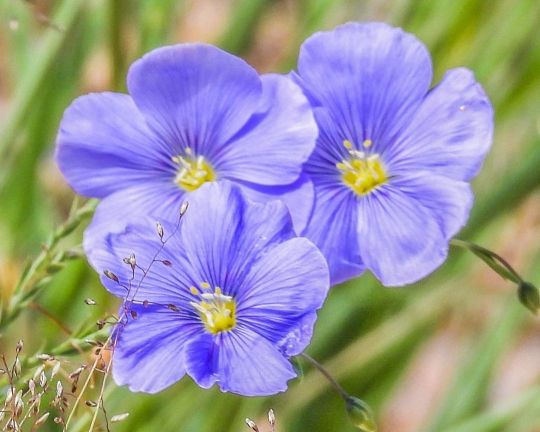
Scenes From My Walk On Saturday - Perennial Flax - Blue Flax #Wildflowers #Flax #PerennialFlax #BlueFlax #Wildflower (at Santa Fe, New Mexico) https://www.instagram.com/p/CfjV7RVgrEt/?igshid=NGJjMDIxMWI=
0 notes
Text
Blue Flax Lily
https://gardeningserenity.com/blue-flax-lily-the-perfect-perennial-for-your-garden/
0 notes
Text
Detailing the Key Concept
What Plants should be Included? considering plants that are shown as being native to Hamilton, and are also included in the free Indigenous plant species that the Brisbane City Council provides
blue flax lily (dianella caerulea) -> attracts birds & lizards; edible blueberries; leaves traditionally used for cord & string; fruit juice can serve as antiseptic for sea ulcers
matrush (lomandra filiformis) -> attracts lizards & frogs; edible base of leaves, flowers & seeds; roots were used as medicine for insect bites
tea tree (leptospermum whitei) -> attracts insects & bees; leaves crushed & inhaled to alleviate colds/coughs; creating tea tree oil (anti-bacterial & anti-fungal)
bottlebrush (callistemon) -> attracts birds & insects; can make tea out of leaves & blossoms
myrtle (melaleuca; backhousia) -> attracts birds & insects; edible flowers, leaves & berries; creating oil (anti-bacterial & anti-fungal)
banksia (banksia) -> attracts birds; edible flowers, leaves & seeds; leaves can make tea; root is anthelmintic
tukeroo (cupaniopsis anacardioides) -> attracts birds, bees & insects; edible fruit & tubers
Implementation Plan
As the Northshore Hamilton area is legally owned by EDQ, it qualifies as Council land, making it an area that is automatically eligible to receive 50 free plants from the Brisbane City Council
EDQ requests plants listed above from Council -> utilises existing plants to grow more
once garden is eventually developed, public access opens, within specified time periods
classes/workshops will be led by willing members of Indigenous communities/people who are well-versed in botany -> free/discounted tickets for site residents; payments generate revenue for EDQ
Sources
Native plant species
Council offers a variety of plants through the Free Native Plants Program, suitable for all garden types and sizes.
BRISBANE.QLD.GOV.AU
PPNN.ORG.AU
Blue Flax Lilly - Dianella caerulea - Care Guide
Dianella caerulea! Commonly known as the blue flax-lily, blueberry lily, or paroo lily, this sub-tropical is native across the eastern state
MELBOURNE BUSHFOOD
'POKULBI' PAROO LILY / BLUE FLAX (Dianella caerulea) 'Bush Tucker Plant Seeds'
A plant which keeps growing from year to year. It forms mats. It grows to 0.75 m high and spreads to 0.4 m across.A hardy perennial native h
EDIBLE OZ
GREEN / CREEK MAT RUSH (Lomandra hystrix) 'Bush Tucker Plant Seeds'
Lomandra hystrix, commonly known as green mat-rush, or creek mat-rush, is a perennial, rhizomatous herb found throughout eastern Australia.
EDIBLE OZ
Tea Tree: The Protector - Wonderground
An exploration of the historical, medicinal and cultural uses of the Australian Tea Tree. A lovely read!
WONDERGROUND|GEORGINA REID
Bottlebrush Tree: Tea, Medicinal Uses & Growing Guide | ForagingGuru
Bottlebrush trees can be used as a gorgeous evergreen shrub for borders and gardens. They are also edible and great for making tea.
FORAGINGGURU
Are Myrtle Flowers Edible?
Common myrtle shrubs (Myrtus communis) produce beautiful, small white flowers during summer and fall. Although these flowers look attractive
PETAL REPUBLIC|EDWARD HODSDON
MYRTLE: Overview, Uses, Side Effects, Precautions, Interactions, Dosing and Reviews
Learn more about MYRTLE uses, effectiveness, possible side effects, interactions, dosage, user ratings and products that contain MYRTLE.
WEBMD.COM
medicinal herbs: BANKSIA ROSE - Rosa banksiae
Natutal medicine can heal your body and mind. Medicinal herbs: Banksia Rose (Rosa banksiae)
NATURALMEDICINALHERBS.NET
FILES-PREPROD-D9.NORTHERNBEACHES.NSW.GOV.AU
0 notes
#blog#creative#journal#creativeconceptjournal#entrepreneur#entrepreneurship#northshore#northshorehamilton#brisbane#meanjin#qld#queensland#edq#economicdevelopmentqueensland#economicdevelopmentqld
0 notes
